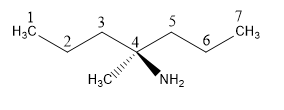Reactions of Ethers
Ethers (R-O-R’) are compounds formed by replacing hydrogen atoms of an alcohol (R-OH compound) or a phenol (C6H5OH) by an aryl/ acyl group (functional group after removing single hydrogen from an aromatic ring). In this section, reaction, preparation and behavior of ethers are discussed in the context of organic chemistry.
Epoxides
Epoxides are a special class of cyclic ethers which are an important functional group in organic chemistry and generate reactive centers due to their unusual high reactivity. Due to their high reactivity, epoxides are considered to be toxic and mutagenic.
Williamson Ether Synthesis
An organic reaction in which an organohalide and a deprotonated alcohol forms ether is known as Williamson ether synthesis. Alexander Williamson developed the Williamson ether synthesis in 1850. The formation of ether in this synthesis is an SN2 reaction.

First identify the longest carbon chain. The longest parent chain contains 7 carbon atoms.

The substituent group present are amine and a methyl group attached to the 4th carbon atom. As two substituent groups are present in the same carbon atom they are named in alphabetical order i.e first amine then methyl wherein the number in front of the substituent groups name in the IUPAC name signifies their position.
Also while writing the IUPAC name dashes are used between number and alphabet.
So , the IUPAC name of the given compound is,
4-amine-4-methylheptane
Step by step
Solved in 2 steps with 2 images









